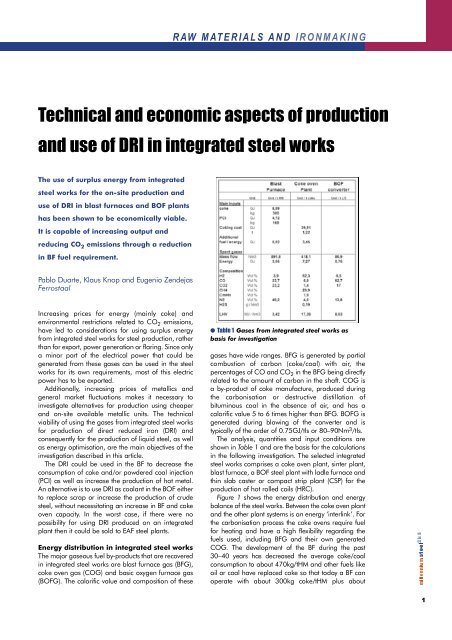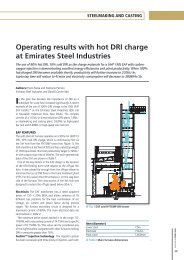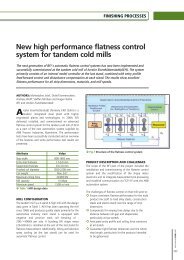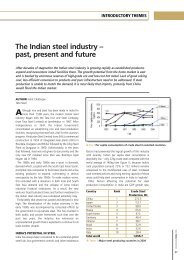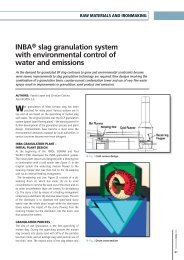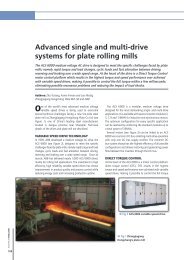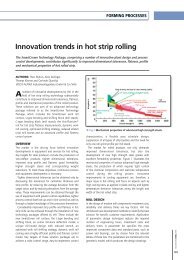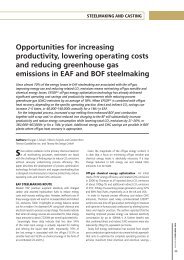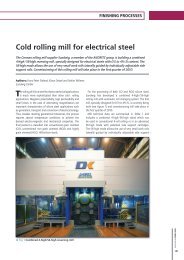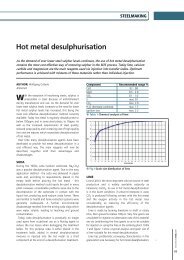Technical and economic aspects of production and use of DRI in ...
Technical and economic aspects of production and use of DRI in ...
Technical and economic aspects of production and use of DRI in ...
You also want an ePaper? Increase the reach of your titles
YUMPU automatically turns print PDFs into web optimized ePapers that Google loves.
Increas<strong>in</strong>g prices for energy (ma<strong>in</strong>ly coke) <strong>and</strong><br />
environmental restrictions related to CO 2 e m i s s i o n s ,<br />
have led to considerations for us<strong>in</strong>g surplus energy<br />
from <strong>in</strong>tegrated steel works for steel <strong>production</strong>, rather<br />
than for export, power generation or flar<strong>in</strong>g. S<strong>in</strong>ce only<br />
a m<strong>in</strong>or part <strong>of</strong> the electrical power that could be<br />
generated from these gases can be <strong>use</strong>d <strong>in</strong> the steel<br />
works for its own requirements, most <strong>of</strong> this electric<br />
power has to be exported.<br />
A d d i t i o n a l l y, <strong>in</strong>creas<strong>in</strong>g prices <strong>of</strong> metallics <strong>and</strong><br />
general market fluctuations makes it necessary to<br />
<strong>in</strong>vestigate alternatives for <strong>production</strong> us<strong>in</strong>g cheaper<br />
<strong>and</strong> on-site available metallic units. The technical<br />
viability <strong>of</strong> us<strong>in</strong>g the gases from <strong>in</strong>tegrated steel works<br />
for <strong>production</strong> <strong>of</strong> direct reduced iron (<strong>DRI</strong>) <strong>and</strong><br />
consequently for the <strong>production</strong> <strong>of</strong> liquid steel, as well<br />
as energy optimisation, are the ma<strong>in</strong> objectives <strong>of</strong> the<br />
<strong>in</strong>vestigation described <strong>in</strong> this article.<br />
The <strong>DRI</strong> could be <strong>use</strong>d <strong>in</strong> the BF to decrease the<br />
consumption <strong>of</strong> coke <strong>and</strong>/or powdered coal <strong>in</strong>jection<br />
(PCI) as well as <strong>in</strong>crease the <strong>production</strong> <strong>of</strong> hot metal.<br />
An alternative is to <strong>use</strong> <strong>DRI</strong> as coolant <strong>in</strong> the BOF either<br />
to replace scrap or <strong>in</strong>crease the <strong>production</strong> <strong>of</strong> crude<br />
steel, without necessitat<strong>in</strong>g an <strong>in</strong>crease <strong>in</strong> BF <strong>and</strong> coke<br />
oven capacity. In the worst case, if there were no<br />
possibility for us<strong>in</strong>g <strong>DRI</strong> produced on an <strong>in</strong>tegrated<br />
plant then it could be sold to EAF steel plants.<br />
Energy distribution <strong>in</strong> <strong>in</strong>tegrated steel works<br />
The major gaseous fuel by-products that are recovered<br />
<strong>in</strong> <strong>in</strong>tegrated steel works are blast furnace gas (BFG),<br />
coke oven gas (COG) <strong>and</strong> basic oxygen furnace gas<br />
(BOFG). The calorific value <strong>and</strong> composition <strong>of</strong> these<br />
R AW M AT E R I A L S A N D I R O N M A K I N G<br />
<strong>Technical</strong> <strong>and</strong> <strong>economic</strong> <strong>aspects</strong> <strong>of</strong> <strong>production</strong><br />
<strong>and</strong> <strong>use</strong> <strong>of</strong> <strong>DRI</strong> <strong>in</strong> <strong>in</strong>tegrated steel works<br />
The <strong>use</strong> <strong>of</strong> surplus energy from <strong>in</strong>tegrated<br />
steel works for the on-site <strong>production</strong> <strong>and</strong><br />
<strong>use</strong> <strong>of</strong> <strong>DRI</strong> <strong>in</strong> blast furnaces <strong>and</strong> BOF plants<br />
has been shown to be <strong>economic</strong>ally viable.<br />
It is capable <strong>of</strong> <strong>in</strong>creas<strong>in</strong>g output <strong>and</strong><br />
reduc<strong>in</strong>g CO 2 emissions through a reduction<br />
<strong>in</strong> BF fuel requirement.<br />
Pablo Duarte, Klaus Knop <strong>and</strong> Eugenio Zendejas<br />
Ferrostaal<br />
● Table 1 Gases from <strong>in</strong>tegrated steel works as<br />
basis for <strong>in</strong>vestigation<br />
gases have wide ranges. BFG is generated by partial<br />
combustion <strong>of</strong> carbon (coke/coal) with air, the<br />
percentages <strong>of</strong> CO <strong>and</strong> CO 2 <strong>in</strong> the BFG be<strong>in</strong>g directly<br />
related to the amount <strong>of</strong> carbon <strong>in</strong> the shaft. COG is<br />
a by-product <strong>of</strong> coke manufacture, produced dur<strong>in</strong>g<br />
the carbonisation or destructive distillation <strong>of</strong><br />
bitum<strong>in</strong>ous coal <strong>in</strong> the absence <strong>of</strong> air, <strong>and</strong> has a<br />
calorific value 5 to 6 times higher than BFG. BOFG is<br />
generated dur<strong>in</strong>g blow<strong>in</strong>g <strong>of</strong> the converter <strong>and</strong> is<br />
typically <strong>of</strong> the order <strong>of</strong> 0.75GJ/tls or 80–90Nm 3 / t l s .<br />
The analysis, quantities <strong>and</strong> <strong>in</strong>put conditions are<br />
shown <strong>in</strong> Table 1 <strong>and</strong> are the basis for the calculations<br />
<strong>in</strong> the follow<strong>in</strong>g <strong>in</strong>vestigation. The selected <strong>in</strong>tegrated<br />
steel works comprises a coke oven plant, s<strong>in</strong>ter plant,<br />
blast furnace, a BOF steel plant with ladle furnace <strong>and</strong><br />
th<strong>in</strong> slab caster or compact strip plant (CSP) for the<br />
<strong>production</strong> <strong>of</strong> hot rolled coils (HRC).<br />
Figure 1 shows the energy distribution <strong>and</strong> energy<br />
balance <strong>of</strong> the steel works. Between the coke oven plant<br />
<strong>and</strong> the other plant systems is an energy ‘<strong>in</strong>terl<strong>in</strong>k’. Fo r<br />
the carbonisation process the coke ovens require fuel<br />
for heat<strong>in</strong>g <strong>and</strong> have a high flexibility regard<strong>in</strong>g the<br />
fuels <strong>use</strong>d, <strong>in</strong>clud<strong>in</strong>g BFG <strong>and</strong> their own generated<br />
C O G. The development <strong>of</strong> the BF dur<strong>in</strong>g the past<br />
30–40 years has decreased the average coke/coal<br />
consumption to about 470kg/tHM <strong>and</strong> other fuels like<br />
oil or coal have replaced coke so that today a BF can<br />
operate with about 300kg coke/tHM plus about<br />
1
2<br />
R AW M AT E R I A L S A N D I R O N M A K I N G<br />
● Figure 1 Overall balance for <strong>in</strong>tegrated steel works based on<br />
HRC <strong>production</strong><br />
● Figure 2 Overall balance with <strong>in</strong>tegrated <strong>DRI</strong> plant<br />
170kg/tHM powdered coal. From the BOF plant the<br />
BOFG is cooled <strong>and</strong> purified <strong>and</strong> collected <strong>in</strong> a<br />
g a s h o l d e r, which also fulfils the task <strong>of</strong> a buffer for<br />
further cont<strong>in</strong>uous delivery to consumers.<br />
The major steel works applications where gaseous<br />
fuels are <strong>use</strong>d are:<br />
● Figure 3 HYL Zero reformer process<br />
■ Coke oven heat<strong>in</strong>g<br />
■ Blast furnace stoves<br />
■ Soak<strong>in</strong>g pits<br />
■ Reheat<strong>in</strong>g furnaces<br />
■ Ladle/tundish preheat<strong>in</strong>g <strong>and</strong> so on<br />
As shown <strong>in</strong> Figure 1, for a balanced conventional<br />
<strong>in</strong>tegrated steel mill <strong>of</strong> the type described, about 32%<br />
<strong>of</strong> the fossil primary energy is surplus gas, which is<br />
<strong>use</strong>d ma<strong>in</strong>ly for power generation. The total amount<br />
<strong>of</strong> electric power that can be produced (assum<strong>in</strong>g<br />
36% efficiency), is approximately 560kWh/t HRC.<br />
About 220kWh/t HRC is <strong>use</strong>d for <strong>in</strong>-plant<br />
requirements <strong>and</strong> the rema<strong>in</strong><strong>in</strong>g 340kWh/t HRC has<br />
to be exported.<br />
Incorporation <strong>of</strong> a <strong>DRI</strong> plant <strong>in</strong> an <strong>in</strong>tegrated<br />
steel works<br />
Figure 2 gives an overview <strong>of</strong> this idea by simply<br />
replac<strong>in</strong>g the power plant <strong>in</strong> Figure 1 with a <strong>DRI</strong> plant.<br />
The figure shows <strong>DRI</strong> <strong>production</strong>, energy balance <strong>and</strong><br />
C O 2 emissions. The maximum <strong>production</strong> <strong>of</strong> <strong>DRI</strong> <strong>in</strong><br />
this steel works is ~380kg/tls.<br />
For this application, spent gases from the <strong>in</strong>tegrated<br />
steel mill are sent to the <strong>DRI</strong> plant <strong>and</strong> split as follows:<br />
■ COG <strong>and</strong> BOFG are totally <strong>use</strong>d as process gas for<br />
<strong>DRI</strong> <strong>production</strong><br />
■ Required amount <strong>of</strong> BFG is <strong>use</strong>d as fuel for reduc<strong>in</strong>g<br />
gas heat<strong>in</strong>g <strong>and</strong> steam generation<br />
As can be seen from Figure 2 there is a surplus <strong>of</strong><br />
purge gas (tail gas), ma<strong>in</strong>ly due to the need for N 2<br />
p u r g i n g, which is ma<strong>in</strong>ly concentrated <strong>in</strong> the BOFG.<br />
Excess tail gas from the reduction circuit is sent to the<br />
steel works for <strong>use</strong> <strong>in</strong> the coke oven plant <strong>and</strong>/or <strong>in</strong> the<br />
roll<strong>in</strong>g mill, or other consumers.<br />
The <strong>in</strong>vestigation <strong>of</strong> the <strong>use</strong> <strong>of</strong> COG as well as<br />
BOFG <strong>in</strong> a <strong>DRI</strong> plant is based on the HYL Selfreform<strong>in</strong>g<br />
or ZR process technology, with optimum<br />
reduction efficiency via generation <strong>of</strong> the reduc<strong>in</strong>g gas<br />
<strong>in</strong> the reduction section itself. As a result, an external<br />
reformer unit or alternative reduc<strong>in</strong>g gas generation<br />
system is not needed <strong>and</strong> no special treatment <strong>of</strong> the<br />
gases is required.<br />
HYL ZR – DR process<br />
This process (see Figure 3) is based on the reduction<br />
<strong>of</strong> iron ores with reduc<strong>in</strong>g gases, which are<br />
generated from partial combustion <strong>and</strong> <strong>in</strong>-s i t u<br />
reform<strong>in</strong>g <strong>of</strong> natural gas or COG, tak<strong>in</strong>g advantage<br />
<strong>of</strong> the catalytic effect <strong>of</strong> the metallic iron <strong>in</strong>side the<br />
reduction reactor. [Duarte P, Knop K, <strong>and</strong> Masloch P,<br />
The HYL m<strong>in</strong>i-module concept: The optimum<br />
<strong>in</strong>tegration <strong>of</strong> a DR plant <strong>in</strong> m<strong>in</strong>imills, MPT<br />
International, pp74–81, April, 2002.]
● Table 2 <strong>DRI</strong> product characteristics<br />
Beca<strong>use</strong> <strong>of</strong> partial combustion, the reduc<strong>in</strong>g gas<br />
temperature at the reactor <strong>in</strong>let is very high – above<br />
1,000°C, but due to the endothermic behaviour <strong>of</strong> the<br />
comb<strong>in</strong>ed chemical reactions tak<strong>in</strong>g place <strong>in</strong>side the<br />
r e a c t o r, the result<strong>in</strong>g temperature at the reduction zone<br />
is below the potential condition for material cluster<br />
f o r m a t i o n .<br />
The process <strong>in</strong>cludes the follow<strong>in</strong>g features which,<br />
when comb<strong>in</strong>ed, elim<strong>in</strong>ate the need for a reduc<strong>in</strong>g<br />
gas generation system:<br />
■ Partial combustion <strong>of</strong> the reduc<strong>in</strong>g gas Pa r t i a l<br />
combustion <strong>of</strong> COG/BOFG with oxygen before the<br />
reactor <strong>in</strong>let provides the additional energy, which is<br />
required for methane-reform<strong>in</strong>g <strong>in</strong> situ, <strong>and</strong> for the<br />
carburisation <strong>of</strong> the metallic iron<br />
■ I n -situ reform<strong>in</strong>g <strong>in</strong> the lower part <strong>of</strong> the<br />
reactor reduction zone Once <strong>in</strong> contact with the<br />
solids <strong>in</strong>side the reactor, further methane (from the<br />
COG) reform<strong>in</strong>g <strong>in</strong> situ takes place due to the<br />
catalytic effect <strong>of</strong> the metallic iron<br />
■ Adjustable composition <strong>of</strong> the reduc<strong>in</strong>g gas<br />
The level <strong>of</strong> metallisation <strong>and</strong> carbon can be<br />
controlled <strong>in</strong>dependently by adjust<strong>in</strong>g ma<strong>in</strong> process<br />
parameters <strong>and</strong> the gas composition<br />
A schematic <strong>of</strong> the Hyl ZR process is shown <strong>in</strong> Figure 4.<br />
The reactor operates at elevated pressure (4–6 bar,<br />
absolute), allow<strong>in</strong>g a high reactor productivity <strong>of</strong> about<br />
1 0 t / h / m 2 <strong>and</strong> m<strong>in</strong>imum dust losses through top gas<br />
c a r r y-o v e r. This is reflected <strong>in</strong> low iron ore<br />
consumption, which helps keep operat<strong>in</strong>g cost low.<br />
The top gas leav<strong>in</strong>g the reactor conta<strong>in</strong>s H 2 O <strong>and</strong><br />
C O 2 generated from the reduction process. These<br />
components are elim<strong>in</strong>ated through a top gas<br />
scrubb<strong>in</strong>g system to remove the water <strong>and</strong>, optionally,<br />
a CO 2-removal system <strong>in</strong> the recycle gas.<br />
R AW M AT E R I A L S A N D I R O N M A K I N G<br />
● Figure 4 Pr<strong>in</strong>ciples <strong>of</strong> HYL III – process schematic<br />
The reduc<strong>in</strong>g gas, made up <strong>of</strong> recycled gas <strong>and</strong><br />
C O G / B O F G, is reheated to 930°C <strong>in</strong> the gas heater<br />
<strong>and</strong> the tail gas from the reduction circuit is send to<br />
● Figure 5 Energy/mass – Balance <strong>of</strong> HYL- Z R- process on basis <strong>of</strong><br />
gases from <strong>in</strong>tegrated steel works<br />
consumers <strong>in</strong> the steel works or optionally to the<br />
h e a t e r. The plant can be designed for <strong>production</strong> <strong>of</strong><br />
cold <strong>DRI</strong> or hot <strong>DRI</strong> for direct charg<strong>in</strong>g to a melt<strong>in</strong>g<br />
facility <strong>and</strong>/or for hot briquett<strong>in</strong>g <strong>and</strong> <strong>production</strong> <strong>of</strong><br />
HBI. The ma<strong>in</strong> characteristics <strong>of</strong> possible DR products<br />
are shown <strong>in</strong> Table 2.<br />
The process scheme is based on the same<br />
successfully proven Hyl ZR technology, that has been <strong>in</strong><br />
operation at <strong>in</strong>dustrial scale <strong>in</strong> the ‘4M’ plant s<strong>in</strong>ce<br />
1998, <strong>and</strong> which was recently <strong>in</strong>corporated <strong>in</strong> the<br />
‘3M5’ plant, both at Hylsa facilities <strong>in</strong> Monterrey,<br />
M e x i c o .<br />
Integration <strong>of</strong> the <strong>DRI</strong> plant<br />
The calculation <strong>of</strong> the reduction gas composition,<br />
us<strong>in</strong>g either natural gas or a mixture <strong>of</strong> COG <strong>and</strong><br />
BOFG <strong>in</strong> the Hyl ZR process is shown <strong>in</strong> Figure 5. As<br />
the COG/BOFG <strong>and</strong> natural gas-based ZR schemes<br />
are similar, no technological risks are foreseen by<br />
<strong>in</strong>corporat<strong>in</strong>g this <strong>DRI</strong> technology <strong>in</strong>to <strong>in</strong>tegrated mills.<br />
It is important to note that untreated COG may also be<br />
<strong>use</strong>d <strong>in</strong> the Hyl technology for <strong>production</strong> <strong>of</strong> <strong>DRI</strong>.<br />
Figure 6 shows possibilities for operation <strong>of</strong> the<br />
plant. The <strong>DRI</strong> <strong>production</strong> rate <strong>and</strong> consequently the<br />
3
4<br />
R AW M AT E R I A L S A N D I R O N M A K I N G<br />
● Figure 6 Integration <strong>of</strong> <strong>DRI</strong> plant with <strong>use</strong> <strong>of</strong> different process<br />
s c h e m e s<br />
amount <strong>of</strong> spent tail gas can be adjusted. Depend<strong>in</strong>g<br />
on the <strong>DRI</strong> requirements <strong>and</strong> additional fuel needs for<br />
the different facilities <strong>in</strong> the steel works, the <strong>production</strong><br />
<strong>of</strong> <strong>DRI</strong> can be optimised. This means surplus tail gas is<br />
m<strong>in</strong>imised or can be controlled <strong>in</strong> such a way that the<br />
required amount <strong>of</strong> fuel can be balanced by<br />
<strong>in</strong>creas<strong>in</strong>g or decreas<strong>in</strong>g <strong>DRI</strong> <strong>production</strong>.<br />
Use <strong>of</strong> <strong>DRI</strong> <strong>in</strong> <strong>in</strong>tegrated steel works<br />
<strong>DRI</strong> can be <strong>use</strong>d either <strong>in</strong> the BF or <strong>in</strong> the BOF.<br />
Case 1: Charg<strong>in</strong>g cold <strong>DRI</strong> to the BF<br />
[Becerra J, <strong>and</strong> Yañez D, Why <strong>DRI</strong> has become an<br />
attractive alternative to blast furnace operators, Iron<br />
<strong>and</strong> Steel International, pp43–49, February 1980]<br />
The basis for this analysis is:<br />
■ BF us<strong>in</strong>g 300kg <strong>of</strong> coke <strong>and</strong> 170kg <strong>of</strong> PCI/t HM.<br />
■ <strong>DRI</strong> <strong>production</strong> us<strong>in</strong>g COG <strong>and</strong> BOFG is about<br />
350kg/t HM<br />
■ 94% metallisation <strong>and</strong> 4% carbon<br />
Figure 7 presents the schematic balance <strong>in</strong> more detail<br />
for the BF with (coloured red), <strong>and</strong> without (coloured<br />
black) charg<strong>in</strong>g <strong>DRI</strong>. The same liquid steel <strong>production</strong><br />
rate has been kept.<br />
The ma<strong>in</strong> <strong>in</strong>fluenced parameters are:<br />
■ PCI consumption<br />
■ Oxygen consumption<br />
■ Amount <strong>of</strong> top gas<br />
■ B u r d e n<br />
In this case, the ma<strong>in</strong> target is reduction <strong>of</strong> the<br />
environmental impact due to a decrease <strong>in</strong> CO 2<br />
emissions by lower<strong>in</strong>g PCI consumption. There is a<br />
reduction <strong>of</strong> about 70% <strong>of</strong> PCI/tHM <strong>and</strong> a potential<br />
● Figure 7 Example <strong>of</strong> charg<strong>in</strong>g <strong>DRI</strong> to blast furnace<br />
decrease <strong>of</strong> CO 2 emission <strong>of</strong> about 28%,<br />
consider<strong>in</strong>g the selective elim<strong>in</strong>ation from the <strong>DRI</strong><br />
plant, which should be delivered/disposed <strong>of</strong> for<br />
other purposes than vent<strong>in</strong>g.<br />
The <strong>in</strong>fluence <strong>of</strong> <strong>DRI</strong>/HBI feed to the BF has been<br />
reported at many facilities worldwide. In general,<br />
most <strong>of</strong> the studies agree to an <strong>in</strong>crease <strong>of</strong> 6–7% <strong>in</strong><br />
<strong>production</strong> with 100kg <strong>DRI</strong>/t HM, keep<strong>in</strong>g the same<br />
consumption <strong>in</strong> coke <strong>and</strong> PCI. [ Kercsmar D, Ya m a u c h i<br />
Y, Dibert W, <strong>and</strong> Kleather J, Susta<strong>in</strong>ed <strong>production</strong> <strong>in</strong><br />
excess <strong>of</strong> 9 tons per day/100cu. ft. W. V. at Middletown<br />
No. 3 blast furnace, Ironmak<strong>in</strong>g Conference<br />
Proceed<strong>in</strong>gs, pp443–450, 1994 ]<br />
Case 2: Hot charg<strong>in</strong>g <strong>DRI</strong> to BOF<br />
An alternate possibility for higher liquid steel<br />
<strong>production</strong> is to feed the <strong>DRI</strong> <strong>in</strong>to a BOF ( Figure 8).<br />
For this case, only hot <strong>DRI</strong> is fed to the BOF <strong>and</strong> the<br />
● Table 3 Production costs for <strong>DRI</strong>
temperature <strong>of</strong> the HM was assumed as 1,500°C.<br />
There is a maximum possible crude steel <strong>production</strong><br />
<strong>of</strong> about 1.4t/tHM, compared to a conventional<br />
scrap based case <strong>of</strong> 1.2t/tHM. The <strong>production</strong><br />
<strong>in</strong>crease is about 15.3%.<br />
Economics<br />
Energy cost The cost <strong>of</strong> surplus gas from <strong>in</strong>tegrated<br />
steel works (<strong>use</strong>d for electrical power generation)<br />
has to be based on the price <strong>of</strong> steam coal for power<br />
generation. In this situation, the cost for electrical<br />
power has been calculated under German<br />
conditions as 1.5US$/GJ <strong>and</strong> is <strong>use</strong>d for calculation<br />
<strong>of</strong> the <strong>DRI</strong> <strong>production</strong> cost, as the equivalent energy<br />
cost <strong>of</strong> COG/BOFG. BF top gas is assumed as<br />
0.5US$/GJ.<br />
Production cost for <strong>DRI</strong>/tls A <strong>DRI</strong> <strong>production</strong> cost<br />
estimation, exclud<strong>in</strong>g the <strong>in</strong>vestment <strong>and</strong> f<strong>in</strong>anc<strong>in</strong>g<br />
cost (which depends strongly on the concept <strong>and</strong><br />
degree <strong>of</strong> <strong>in</strong>tegration <strong>of</strong> the <strong>DRI</strong> plant), is <strong>in</strong>cluded <strong>in</strong><br />
Table 3. The feedstock is made up <strong>of</strong> 50% pellets <strong>and</strong><br />
50% lump ore, with a calculated <strong>DRI</strong> cost <strong>of</strong> about<br />
77US$/t, or about half the price <strong>of</strong> scrap. It is<br />
expected that there would be a decrease <strong>in</strong> the<br />
<strong>production</strong> cost <strong>of</strong> HM <strong>and</strong> liquid steel to some<br />
e x t e n t .<br />
Table 4 shows a comparison between a scrapbased<br />
<strong>and</strong> hot <strong>DRI</strong>-based <strong>production</strong> <strong>of</strong> liquid steel.<br />
The difference <strong>of</strong> about 21US$/tls is ma<strong>in</strong>ly related to<br />
the scrap price, which is assumed to be about<br />
150US$/t. To compete with the price for steel made<br />
out <strong>of</strong> <strong>DRI</strong>, the scrap price has to be as low as about<br />
6 0 U S $ / t .<br />
Conclusions<br />
The ma<strong>in</strong> issues fac<strong>in</strong>g <strong>in</strong>tegrated steel works are:<br />
■ Limited supply <strong>and</strong> <strong>in</strong>creas<strong>in</strong>g prices <strong>of</strong> coke <strong>and</strong><br />
s c r a p<br />
■ Environmental restrictions related to CO 2 e m i s s i o n s ,<br />
which could be <strong>of</strong> <strong>economic</strong> importance due to<br />
regulations/trad<strong>in</strong>g <strong>aspects</strong> envisioned <strong>in</strong> the Ky o t o<br />
p r o t o c o l<br />
By modify<strong>in</strong>g the current trend <strong>of</strong> us<strong>in</strong>g spent gases<br />
from the <strong>in</strong>tegrated facility for power generation,<br />
these issues can be overcome by us<strong>in</strong>g them for more<br />
v a l u e-added <strong>DRI</strong> <strong>production</strong> while reduc<strong>in</strong>g fossil<br />
fuel consumption <strong>and</strong> decreas<strong>in</strong>g CO 2 e m i s s i o n s .<br />
R AW M AT E R I A L S A N D I R O N M A K I N G<br />
● Figure 8 Comparison <strong>of</strong> charg<strong>in</strong>g scrap/<strong>DRI</strong> to a BOF<br />
● Table 4 Comparison <strong>of</strong> costs for liquid steel<br />
This work has presented a prelim<strong>in</strong>ary analysis <strong>of</strong><br />
the various approaches for <strong>in</strong>corporation <strong>of</strong> a <strong>DRI</strong><br />
plant <strong>in</strong>to an <strong>in</strong>tegrated steel works. A detailed<br />
<strong>in</strong>vestigation will depend on the particular plant<br />
arrangement <strong>and</strong> <strong>economic</strong> conditions <strong>of</strong> a specific<br />
plant.<br />
Accord<strong>in</strong>g to the general analysis, the ma<strong>in</strong> benefits<br />
a r e :<br />
■ Decrease <strong>of</strong> fossil fuel consumption for HM<br />
<strong>production</strong> <strong>and</strong> CO 2 e m i s s i o n s<br />
■ Potential for <strong>in</strong>crease up to 21% <strong>of</strong> hot metal<br />
<strong>production</strong><br />
■ Increase <strong>of</strong> BOF liquid steel <strong>production</strong> by about<br />
15% us<strong>in</strong>g hot <strong>DRI</strong> as coolant<br />
■ Potential <strong>in</strong>crease <strong>of</strong> about 38% <strong>of</strong> liquid steel by<br />
<strong>in</strong>stall<strong>in</strong>g <strong>DRI</strong> with EAF facilities<br />
Pablo Duarte, Klaus Knop <strong>and</strong> Eugenio Zendejas<br />
are with Ferrostaal, Essen, Germany.<br />
5


